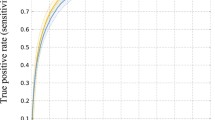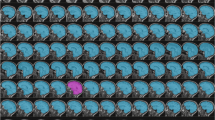Abstract
Objectives
To develop an algorithm to segment and obtain an estimate of total intracranial volume (tICV) from computed tomography (CT) images.
Materials and methods
Thirty-six CT examinations from 18 patients were included. Ten patients were examined twice the same day and eight patients twice six months apart (these patients also underwent MRI). The algorithm combines morphological operations, intensity thresholding and mixture modelling. The method was validated against manual delineation and its robustness assessed from repeated imaging examinations. Using automated MRI software, the comparability with MRI was investigated. Volumes were compared based on average relative volume differences and their magnitudes; agreement was shown by a Bland-Altman analysis graph.
Results
We observed good agreement between our algorithm and manual delineation of a trained radiologist: the Pearson’s correlation coefficient was r = 0.94, tICVml[manual] = 1.05 × tICVml[automated] - 33.78 (R2 = 0.88). Bland-Altman analysis showed a bias of 31 mL and a standard deviation of 30 mL over a range of 1265 to 1526 mL.
Conclusions
tICV measurements derived from CT using our proposed algorithm have shown to be reliable and consistent compared to manual delineation. However, it appears difficult to directly compare tICV measures between CT and MRI.
Key Points
• Automated estimation of tICV is in good agreement with manual tracing.
• Consistent tICV estimations from repeated measurements demonstrate the robustness of the algorithm.
• Automatically segmented volumes seem less variable than those from manual tracing.
• Unbiased and automated tlCV estimation is possible from CT.






Similar content being viewed by others
Abbreviations
- SD:
-
Standard deviation
- tICV:
-
Total intracranial volume
- CT:
-
Computed tomography
- MRI:
-
Magnetic resonance imaging
References
Wattjes MP, Henneman WJP, van der Flier WM et al (2009) Diagnostic imaging of patients in a memory clinic: comparison of MR imaging and 64–detector row CT. Radiology 253:174–183
Guermazi A, Miaux Y, Rovira-Cañellas A et al (2007) Neuroradiological findings in vascular dementia. Neuroradiology 49:1–22
Farias ST, Mungas D, Reed B et al (2012) Maximal brain size remains an important predictor of cognition in old age, independent of current brain pathology. Neurobiol Aging 33:1758–1768
Royle NA, Booth T, Valdés Hernández MC et al (2013) Estimated maximal and current brain volume predict cognitive ability in old age. Neurobiol Aging 34:2726–2733
Courchesne E, Chisum HJ, Townsend J et al (2000) Normal brain development and aging: quantitative analysis at in vivo MR imaging in healthy volunteers. Radiology 216:672–682
Giedd JN, Blumenthal J, Jeffries NO et al (1999) Brain development during childhood and adolescence: a longitudinal MRI study. Nat Neurosci 2:861–863
Keihaninejad S, Heckemann RA, Fagiolo G et al (2010) A robust method to estimate the intracranial volume across MRI field strengths (1.5T and 3T). Neuroimage 50:1427–1437
Nordenskjöld R, Malmberg F, Larsson E-M et al (2013) Intracranial volume estimated with commonly used methods could introduce bias in studies including brain volume measurements. Neuroimage 83:355–360
Simmons A, Westman E, Muehlboeck S et al (2009) MRI measures of alzheimer’s disease and the AddNeuroMed study. Ann N Y Acad Sci 1180:47–55
Simmons A, Westman E, Muehlboeck S et al (2011) The AddNeuroMed framework for multi-centre MRI assessment of Alzheimer’s disease: experience from the first 24 months. Int J Geriatr Psychiatry 26:75–82
Yushkevich PA, Piven J, Cody Hazlett H et al (2006) User-Guided 3D active contour segmentation of anatomical structures: significantly improved efficiency and reliability. Neuroimage 31:1116–1128
Eritaia J, Wood SJ, Stuart GW et al (2000) An optimized method for estimating intracranial volume from magnetic resonance images. Magn Reson Med 44:973–977
Woolrich MW, Jbabdi S, Patenaude B et al (2009) Bayesian analysis of neuroimaging data in FSL. Neuroimage 45:S173–S186
Popescu V, Battaglini M, Hoogstrate WS et al (2012) Optimizing parameter choice for FSL-Brain Extraction Tool (BET) on 3D T1 images in multiple sclerosis. Neuroimage 61:1484–1494
Smith SM, Zhang Y, Jenkinson M et al (2002) Accurate, robust, and automated longitudinal and cross-sectional brain change analysis. Neuroimage 17:479–489
Smith SM, Jenkinson M, Woolrich MW et al (2004) Advances in functional and structural MR image analysis and implementation as FSL. Neuroimage 23:S208
Casella G, Berger RL (2002) Statistical inference. Duxbury Pacific Grove, CA
Garcia V, Nielsen F (2010) Simplification and hierarchical representations of mixtures of exponential families. Signal Process 90:3197–3212
Dice LR (1945) Measures of the amount of ecologic association between species. Ecology 26:297–302
Ruttimann UE, Joyce EM, Rio DE, Eckardt MJ (1993) Fully automated segmentation of cerebrospinal fluid in computed tomography. Psychiatry Res Neuroimaging 50:101–119
Lee TH, Fauzi MFA, Komiya R (2008) Segmentation of CT brain images using K-Means and EM clustering. 2008 Fifth Int Conf Comput Graph Imaging Vis 339–344. doi:10.1109/CGIV.2008.17
Lončarić S, Kovačević D (1997) A method for segmentation of CT head images. Image Anal Process 388–395
Zhang Y, Londos E, Minthon L et al (2008) Usefulness of computed tomography linear measurements in diagnosing Alzheimer’s disease. Acta Radiol 49:91–97
Hamano K, Iwasaki N, Takeya T, Takita H (1993) A comparative study of linear measurement of the brain and three-dimensional measurement of brain volume using CT scans. Pediatr Radiol 23:165–168
Maksimovic R, Stankovic S, Milovanovic D (2000) Computed tomography image analyzer: 3D reconstruction and segmentation applying active contour models–‘snakes’. Int J Med Inform 58–59:29–37
Falahati F, Fereshtehnejad S-M, Religa D et al (2015) The use of MRI, CT and lumbar puncture in dementia diagnostics: data from the SveDem registry. Dement Geriatr Cogn Disord 39:81–91
Skoog I, Olesen PJ, Blennow K et al (2012) Head size may modify the impact of white matter lesions on dementia. Neurobiol Aging 33:1186–1193
Voevodskaya O, Simmons A, Nordenskjöld R et al (2014) The effects of intracranial volume adjustment approaches on multiple regional MRI volumes in healthy aging and Alzheimer’s disease. Front Aging Neurosci. doi:10.3389/fnagi.2014.00264
Ferreira D, Westman E, Eyjolfsdottir H et al (2015) Brain changes in alzheimer’s disease patients with implanted encapsulated cells releasing nerve growth factor. J Alzheimers Dis 43:1059–1072
Acknowledgments
The scientific guarantor of this publication is Dr. Eric Westman. The authors of this manuscript declare no relationships with any companies whose products or services may be related to the subject matter of the article. This study has received funding from the Swedish Brain Power, the Strategic Research Programme in Neuroscience at Karolinska Institutet, the regional agreement on medical training and clinical research (ALF) between Stockholm County Council and Karolinska Institutet, the Swedish Society of Medicine, Loo och Hans Ostermans stiftelse för medicinsk forskning, Stiftelsen för ålderssjukdomar vid Karolinska Institutet, Karolinska Institutets foskningsbidrag, Axel och Signe Lagermans donationsstiftelse. No complex statistical methods were necessary for this paper. Institutional Review Board approval was obtained. Written informed consent was obtained from all subjects (patients) in this study. This data has not been published elsewhere, except in abstract form. Methodology: retrospective, diagnostic or prognostic study, performed at one institution.
Author information
Authors and Affiliations
Corresponding author
Rights and permissions
About this article
Cite this article
Aguilar, C., Edholm, K., Simmons, A. et al. Automated CT-based segmentation and quantification of total intracranial volume. Eur Radiol 25, 3151–3160 (2015). https://doi.org/10.1007/s00330-015-3747-7
Received:
Revised:
Accepted:
Published:
Issue Date:
DOI: https://doi.org/10.1007/s00330-015-3747-7




